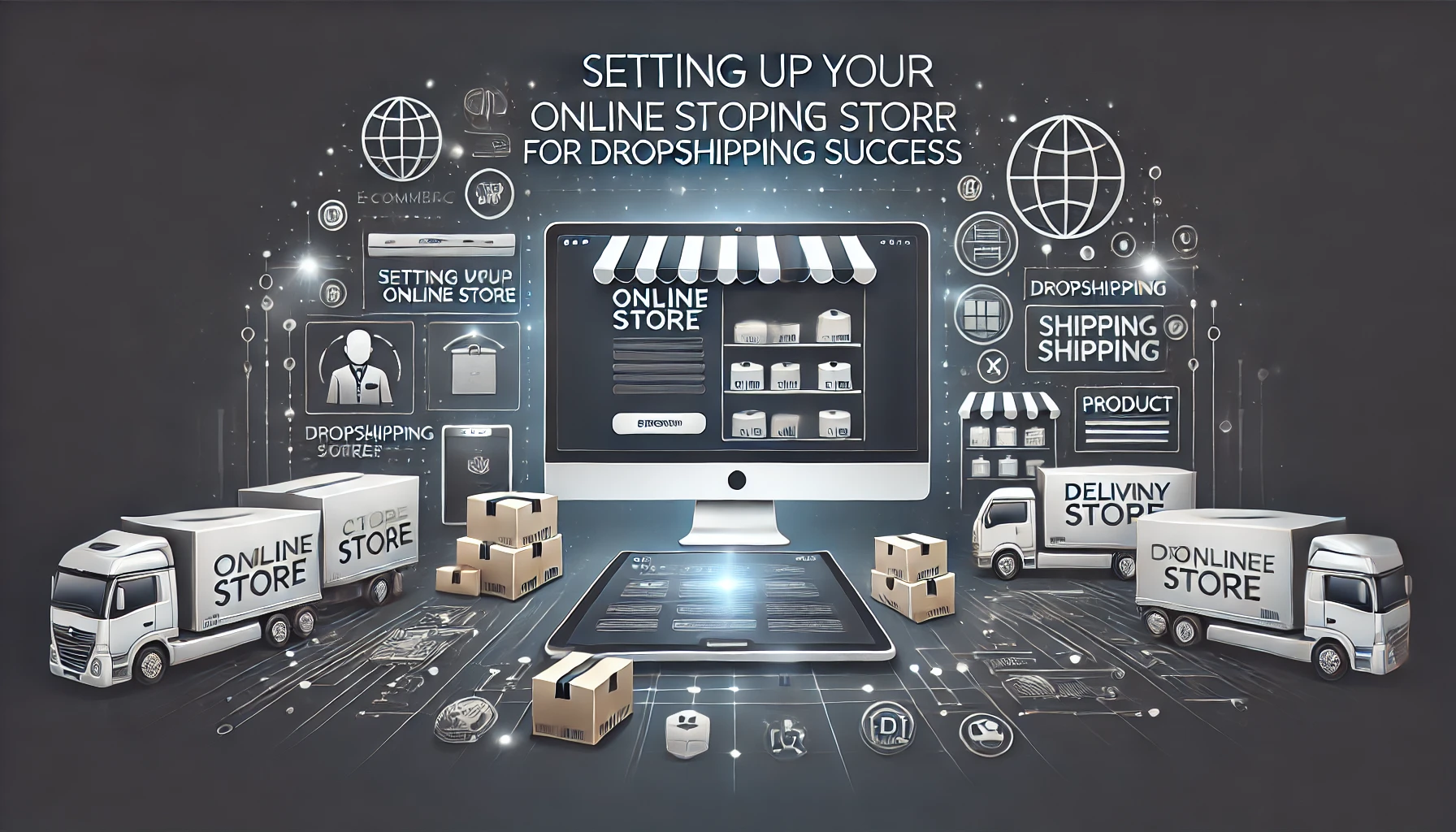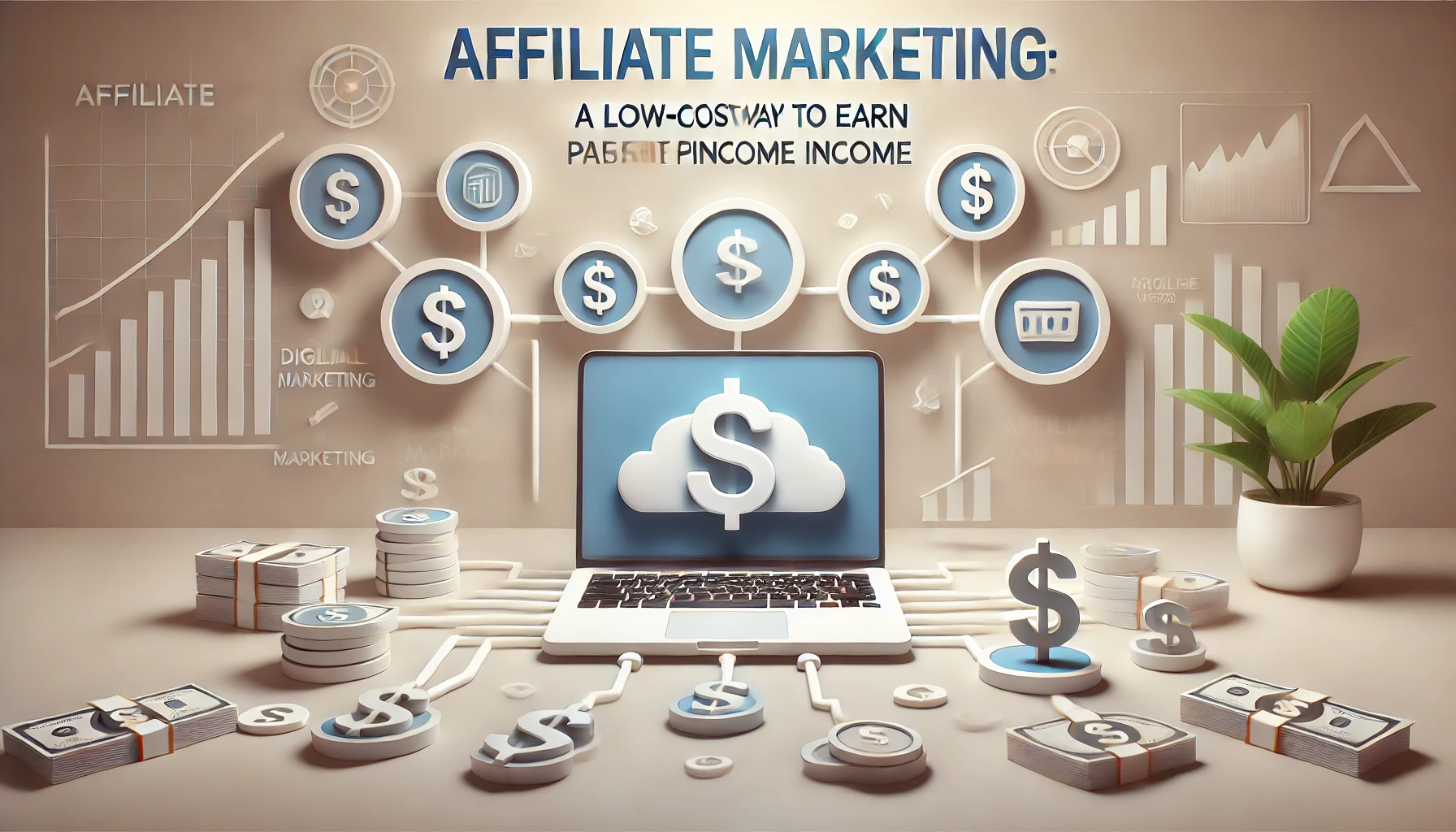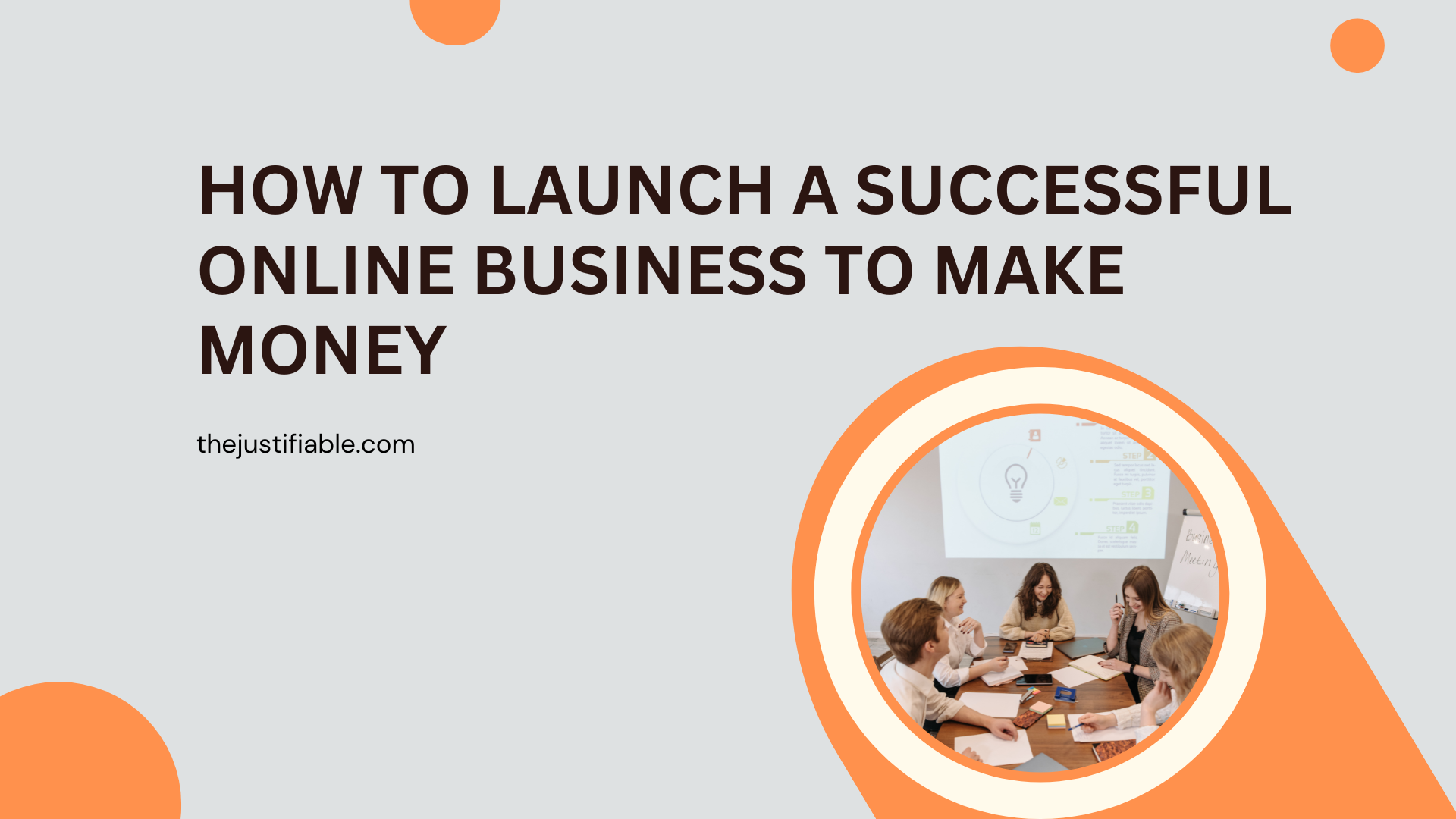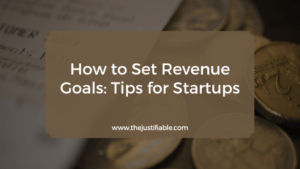Table of Contents
Have you ever wondered what it really takes to launch a successful online business to make money? Are you curious about how beginners can start from scratch and grow profitable ventures using simple strategies?
In this guide, we’ll break down everything you need to know, from choosing the right niche to setting up your store, marketing your business, and managing your finances. By the end, you’ll be ready to kickstart your online business journey with confidence and clarity. Let’s get started!
What Does It Take To Launch A Successful Online Business?
Starting an online business is an exciting journey, but it requires a blend of determination, planning, and strategic action. I believe the first step is understanding the fundamentals, such as choosing the right niche and learning how to reach your target audience. Success often comes from making informed decisions early on.
Equally important is ensuring you have the right tools and resources. You don’t need to invest in every shiny object, but I suggest focusing on quality platforms, hosting, and tools that will support your growth. Building a solid foundation now can save you from headaches down the road.
Understanding The Basics Of An Online Business
I find that the basics of an online business revolve around the same principles as a physical one: you offer a product or service, market it, and earn revenue. However, online businesses give you the advantage of reaching a global audience. You don’t need a storefront; a website acts as your 24/7 shop.
To start, you’ll need to select your business model. Whether it’s dropshipping, affiliate marketing, or selling digital products, I suggest picking a model that matches your skills and interests. This way, you’ll stay motivated and engaged as you grow your business.
Next, create a strong online presence. I’ve learned that building a website or blog is just the beginning. You’ll need to optimize your content, use social media strategically, and engage with potential customers to build trust and credibility.
Don’t underestimate the importance of traffic. I’ve seen many entrepreneurs focus on launching their site but forget that traffic is essential. I recommend exploring both organic and paid methods to drive visitors to your site, as both have unique benefits.
Finally, the power of automation can’t be overstated. Automation tools can help you manage tasks like email marketing, social media scheduling, and inventory management. The right tools will save you time and allow you to focus on growing your business.
Common Pitfalls To Avoid When Starting Out
Many beginners, I’ve noticed, often overlook the importance of planning. Jumping into an online business without clear goals is a major mistake. I recommend outlining your short-term and long-term goals to ensure you’re moving in the right direction and staying motivated through challenges.
I’ve also seen entrepreneurs fail because they didn’t invest time in researching their audience. I suggest spending ample time understanding your potential customers’ needs, desires, and pain points. Without this insight, your products or services may fall flat, no matter how great they are.
Overcomplicating things is another common pitfall. I believe it’s easy to get caught up in trying to perfect your website or branding, but the truth is, done is better than perfect. Launching early gives you time to gather feedback and make improvements as you grow.
A lack of focus can also derail progress. I’ve observed many business owners chase multiple revenue streams too early, spreading themselves thin. I advise honing in on one strategy or product at the start and expanding only after mastering it.
Finally, neglecting marketing is a major setback for many new business owners. Even if you have the best product, it won’t sell if no one knows about it. I always emphasize that marketing should be a priority from day one.
The Mindset You Need For Long-Term Success
In my experience, the right mindset is what sets successful entrepreneurs apart from those who give up too soon. I’ve learned that patience is essential—building a profitable online business takes time, and results don’t happen overnight. Consistency and persistence will get you through the ups and downs.
I’ve also found that embracing failure is crucial. Every setback is an opportunity to learn. When something doesn’t go as planned, I advise reflecting on what went wrong, adjusting your approach, and moving forward. Viewing failure as feedback can help you grow faster.
Another vital aspect is the willingness to adapt. I know that the online landscape is constantly changing, whether it’s SEO trends, social media algorithms, or new technologies. Staying flexible and open to change ensures you’ll stay competitive in an evolving market.
Surround yourself with positivity. I’ve noticed that entrepreneurs often face self-doubt or criticism from others. I suggest joining supportive communities, learning from successful mentors, and celebrating small wins along the way. A strong support network can keep your motivation high.
Lastly, maintain a long-term vision. While it’s easy to get caught up in daily tasks, I find it helpful to remind myself of the bigger picture. Regularly revisiting your “why” can provide the fuel you need to keep pushing forward, even when the journey gets tough.
Why Choosing The Right Niche Can Make Or Break Your Business
The niche you choose is the foundation of your online business. I can’t stress enough how critical this decision is to your success. A niche defines your target audience, your marketing strategy, and your products. Choose wisely, and you’ll set yourself up for long-term profitability.

I believe many beginners rush this step, which leads to costly mistakes down the road. It’s tempting to jump into a popular market, but if that market doesn’t align with your interests or expertise, you’ll struggle to keep up with competitors. Take the time to research and reflect before diving in.
How To Identify A Niche That Aligns With Your Passion
I always recommend starting with your passions. What do you enjoy talking about or working on, even when it doesn’t feel like “work”? Building a business around something you’re passionate about ensures you’ll stay motivated, even during the tough times. Passion can drive you further than profit alone.
However, I think it’s important to find a balance between passion and profitability. Not every hobby or interest will make a lucrative business. I suggest researching market demand and competition in your chosen niche to ensure there’s enough interest to sustain a profitable business.
Once you’ve identified potential niches, test your ideas. I recommend validating your niche by gauging interest from others. You can do this by running surveys, looking at trends on Google or social media, or even starting a blog to see how your content resonates with your audience.
It’s also helpful to look for gaps in the market. I’ve found that niches with high demand but low competition can be golden opportunities. Instead of competing in saturated markets, focus on areas where you can offer something unique or better than what’s already available.
Finally, reflect on your long-term goals. I’ve noticed that some niches are trends, while others are evergreen. I advise choosing a niche with longevity, as this will give you more stability and growth potential as you build your online business.
Researching Your Niche Market To Ensure Profitability
I believe thorough market research is non-negotiable. It’s not enough to pick a niche you’re passionate about; you also need to ensure that it’s profitable. I suggest using tools like Google Trends, SEMrush, or Ubersuggest to evaluate search volume and competition in your niche.
One technique I use is analyzing your potential competitors. What are they doing right, and where are they falling short? I recommend reading customer reviews on competing products or services to identify what people love and what they wish was different. This insight can help you create a superior offer.
Another method I find useful is conducting keyword research. I advise looking for long-tail keywords that reflect buyer intent. These keywords often indicate that consumers are ready to purchase, making them valuable targets for your content and marketing strategies.
In addition, consider testing your niche with a small-scale launch. You can create a minimum viable product (MVP) or service to gauge interest. I’ve seen this approach help entrepreneurs validate demand before fully committing time and resources to a larger launch.
Finally, I think it’s essential to stay adaptable. The market might shift, or new trends could emerge. Keep an eye on industry changes, and be ready to pivot if needed. A profitable niche today could face new challenges tomorrow, so stay informed and agile.
Setting Up Your Online Store For Dropshipping Success
Setting up your online store for dropshipping success requires careful planning and execution. I advise you to begin by choosing a reliable platform, as this forms the backbone of your business. A user-friendly interface will help you manage orders, products, and customers with ease, ensuring smooth operations.

Additionally, I suggest optimizing your store for a seamless user experience. A clean design, fast loading times, and mobile optimization will help convert visitors into buyers. Trust me, focusing on these key details early on will set your dropshipping store up for long-term success.
Choosing The Best Platform For Your Dropshipping Business
Choosing the right platform can make or break your dropshipping business. I recommend starting with Shopify, as it’s beginner-friendly and offers a variety of apps that integrate smoothly with dropshipping. Shopify simplifies setting up a store, and its powerful features help you scale your business efficiently.
I also believe that WooCommerce is a great alternative, especially if you prefer more control over customization. It’s ideal for those who want flexibility, as it integrates with WordPress and offers countless plugins to enhance your store. WooCommerce, though, may require more technical knowledge.
If you’re looking for something more niche-specific, I suggest checking out platforms like BigCommerce. It’s designed for larger stores with robust needs, providing advanced scalability features. This can be a great choice if you plan to grow your dropshipping business rapidly.
Another platform I’ve found useful is Wix. It’s perfect for beginners who want an easy drag-and-drop builder. While it may not offer the same range of apps as Shopify, I think it’s an affordable, simple solution for small dropshipping ventures.
Ultimately, the platform you choose should align with your long-term goals. I recommend considering your business model, budget, and future scalability needs when making this decision. The right platform will support both your current needs and future growth.
How To Source Reliable Suppliers For Dropshipping
Sourcing reliable suppliers is one of the most critical aspects of dropshipping success. I suggest starting with platforms like Spocket, which offers a wide variety of products and allows you to test the quality of suppliers over time. However, quality control is key—so always read reviews carefully.
I’ve also had success with using suppliers from directories like Oberlo or SaleHoo. These platforms vet suppliers to ensure reliability and high product standards. It’s a time-saver for beginners, helping you avoid unreliable suppliers who may delay shipping or deliver poor products.
One strategy I find effective is directly contacting manufacturers. By building relationships with suppliers, you can negotiate better pricing and improve shipping times. I advise maintaining strong communication to ensure your customers get the best possible service.
I also recommend testing product samples before adding them to your store. This will help you confirm product quality, packaging, and shipping times firsthand. I’ve learned that ensuring quality from the beginning helps prevent returns and negative reviews, which can hurt your store’s reputation.
Lastly, always have a backup supplier. I’ve seen cases where businesses rely on one supplier, only to face delays or stock shortages. By diversifying your suppliers, you safeguard your business from potential hiccups and maintain a steady stream of inventory.
Marketing Your Dropshipping Business For Maximum Sales
Marketing your dropshipping business effectively is essential for driving sales. I suggest starting with paid advertising, especially Facebook Ads. Facebook’s targeting options allow you to reach your ideal customer based on interests, behaviors, and demographics. It’s one of the fastest ways to drive traffic to your store.
Content marketing is another great tool. I recommend creating engaging blog posts or videos that highlight your products and address customer pain points. This helps build trust and positions your store as an authority in your niche, ultimately converting readers into buyers over time.
I also advise leveraging social media platforms like Instagram and Pinterest. Visual platforms are ideal for dropshipping, especially if your products are eye-catching. Consistent posting, using relevant hashtags, and engaging with your followers can build brand awareness and drive more organic traffic to your store.
Email marketing is a highly underrated strategy for dropshipping businesses. I’ve found that sending regular updates, product launches, and promotions to an email list helps keep customers engaged and encourages repeat purchases. Be sure to capture emails on your website to build this valuable asset.
Lastly, I recommend experimenting with influencer marketing. Partnering with influencers in your niche can provide instant credibility and reach. I’ve seen dropshipping stores skyrocket in popularity after being featured by the right influencer, especially if the partnership feels authentic and organic.
Affiliate Marketing: A Low-Cost Way To Earn Passive Income
Affiliate marketing is a fantastic way to earn passive income without needing to manage inventory or handle customer service. I suggest beginners start with this model, as it requires minimal upfront investment and allows you to focus on content creation and marketing to drive results.

What’s great about affiliate marketing is that it scales easily. I’ve found that once your website or content gains traction, your affiliate earnings can grow exponentially. Plus, with the right strategies, you can diversify your income streams across multiple affiliate programs.
Choosing The Right Affiliate Programs To Maximize Earnings
Selecting the right affiliate programs is crucial for your success. I advise starting with trusted programs like Flexoffers, as it offers a wide variety of programs and a simple sign-up process. The downside is that the commission rates are lower, but the volume of sales can compensate.
For higher payouts, I suggest looking into specialized affiliate networks like ShareASale or Awin. These platforms connect you with a variety of merchants across different industries, offering competitive commissions. I’ve seen many niche sites succeed by promoting high-ticket items through these networks.
I’ve also had great experiences with private affiliate programs. Many businesses offer exclusive partnerships with affiliates who generate quality traffic. I recommend reaching out directly to companies in your niche to negotiate better commissions and personalized terms.
Don’t forget about digital products! I’ve noticed that promoting online courses, software, or e-books often results in higher earnings, as these products usually come with more generous commissions. Platforms like ClickBank or Rakuten are great places to find digital products to promote.
Lastly, always consider the reputation of the program. I recommend avoiding programs that seem too good to be true or have negative reviews, as your reputation with your audience is at stake. Promote products you believe in to build trust and foster long-term success.
How To Build A High-Converting Affiliate Website
Building a high-converting affiliate website starts with choosing the right niche. I recommend focusing on a niche where you can provide real value to your audience. Your website should be centered around solving problems, educating your readers, or recommending useful products.
I suggest focusing on content creation from the beginning. I’ve found that writing product reviews, how-to guides, and comparison articles help attract targeted traffic. When readers find your content helpful and informative, they’re more likely to click your affiliate links and make a purchase.
Don’t forget the importance of SEO. I recommend optimizing your content for search engines to increase organic traffic. This involves using relevant keywords, creating internal links, and ensuring your site loads quickly. I’ve noticed that well-optimized sites attract more traffic over time, boosting affiliate commissions.
A professional design can also make a big difference. I advise investing in a clean, user-friendly website that’s easy to navigate. Simple layouts, fast load times, and clear calls to action are key to converting visitors into buyers. Avoid clutter, as it can distract visitors from your affiliate offers.
Finally, build trust with your audience. I suggest being transparent about your affiliate relationships and only promoting products you genuinely believe in. I’ve learned that when your audience trusts your recommendations, they’re more likely to make purchases through your links.
Strategies For Driving Traffic To Your Affiliate Links
Driving traffic to your affiliate links is all about creating valuable content and marketing it effectively. I recommend starting with SEO-focused blog posts. Targeting long-tail keywords allows you to rank for specific queries that potential customers are searching for, which brings in highly qualified traffic.
Social media marketing is another powerful strategy. I’ve had great success promoting affiliate links through platforms like Pinterest and Twitter. I suggest sharing visually appealing content or creating engaging posts that encourage people to visit your site or click your links directly.
Email marketing remains one of the most effective methods for affiliate marketers. I advise building an email list and sending regular newsletters filled with useful tips, product recommendations, and exclusive deals. This keeps your audience engaged and increases the chances of affiliate sales.
Another traffic-driving method is guest blogging. I’ve found that writing for reputable sites in your niche can introduce you to a wider audience. When done right, guest blogging not only builds backlinks for SEO but also drives readers directly to your affiliate site.
Lastly, don’t underestimate the power of paid advertising. I recommend using Google Ads or Facebook Ads to promote high-converting affiliate offers. Although there’s an upfront cost, the targeted traffic can lead to more conversions and help you scale your affiliate marketing efforts quickly.
Selling Online Courses: Sharing Your Knowledge For Profit
Selling online courses is a powerful way to monetize your expertise while helping others. I’ve found that sharing knowledge not only builds credibility but also creates passive income streams. When structured well, your course can continue generating revenue for years without significant ongoing effort.

To succeed, I suggest choosing a course topic that solves a real problem. Focus on creating value by addressing the challenges your audience faces. It’s crucial to identify the right audience and tailor your content to their specific needs to increase the demand for your course.
Finding A Course Topic That Solves Real Problems
Finding the right course topic starts with understanding your audience. I recommend starting with areas you’re passionate about or highly knowledgeable in. When you teach something you enjoy, it comes through in your content, making it more engaging and impactful for students.
Another tip I’ve learned is to identify pain points within your industry. I suggest analyzing forums, social media, and other platforms to uncover common questions or challenges people face. If your course can offer solutions, you’re already a step ahead in providing value.
Validating your course idea before fully committing is essential. I advise creating a pilot course or offering a free mini-course to gauge interest. This feedback can help refine your content and ensure there’s a market ready to buy when you launch your full program.
Look at competitors for inspiration. I’ve noticed that studying what others in your niche are teaching can spark new ideas or reveal gaps you can fill. If a competitor’s course lacks depth in certain areas, I recommend expanding on those topics in your content.
Finally, I emphasize solving real-world problems. People invest in courses because they want practical solutions. I advise focusing on actionable steps and offering clear outcomes so your audience feels empowered to implement what they’ve learned.
Platforms To Host Your Online Course For Maximum Exposure
Choosing the right platform for your course is key to reaching a wide audience. I suggest starting with platforms like Udemy or Teachable, which have built-in audiences and tools that make course creation easy. These platforms simplify marketing and course management.
I’ve also found that Thinkific is a solid option for hosting your courses. It allows for great customization, meaning you can create a branded learning experience. I recommend it for those who want more control over their course’s appearance and features.
Kajabi is another strong contender for hosting courses. While it’s pricier, I’ve heard it’s packed with marketing tools that can boost sales. It’s ideal if you plan to run a full-fledged online business with email marketing, automation, and product funnels.
For those who prefer all-in-one platforms, I suggest exploring Podia. It’s user-friendly, cost-effective, and lets you sell memberships, courses, and digital products. I find it perfect for creators who want a simple, straightforward platform without many bells and whistles.
Lastly, you can consider self-hosting your course on WordPress using plugins like LearnDash. While this offers complete flexibility, I advise it only for those comfortable managing tech aspects. Self-hosting gives full control but requires a bit more hands-on work compared to other platforms.
Marketing Strategies To Sell More Courses
Marketing your course effectively is crucial to maximizing sales. I recommend starting with email marketing, which allows you to engage directly with your audience. Build an email list by offering free content like webinars or guides that give a preview of your course.
I also suggest using social proof in your marketing. Testimonials and success stories from previous students can significantly boost trust and conversion rates. I’ve noticed that people are more likely to buy when they see others achieving results from the course.
Paid advertising is another strategy to consider. I’ve seen great results from Facebook and Google Ads campaigns targeting specific audiences interested in your topic. While there’s an upfront cost, I believe the potential return on investment makes it worthwhile.
Content marketing, such as blogging or podcasting, can also help promote your course. I recommend creating valuable content that relates to your course material. This builds credibility and organically attracts potential students who are interested in learning more.
Lastly, affiliate marketing can amplify your reach. I suggest partnering with influencers or bloggers in your niche to promote your course. By offering a commission on sales, you can leverage their audiences to drive more enrollments and grow your business exponentially.
Blogging For Income: Building A Blog That Generates Revenue
Blogging remains one of the most reliable ways to build an online business. I’ve noticed that a well-executed blog can generate multiple streams of income, from ads to sponsorships to digital products. The key is to create content that resonates with your audience and offers real value.

To build a successful blog, I recommend starting with a clear niche. Your blog should focus on a specific area where you can provide in-depth knowledge. Over time, this will position you as an authority and attract readers who are genuinely interested in your content.
Setting Up Your Blog For Long-Term Success
Setting up a blog begins with choosing the right platform. I suggest WordPress, as it offers the best flexibility and control. I’ve used WordPress extensively and found that its vast range of plugins and customization options make it the top choice for serious bloggers.
I also recommend investing in reliable hosting. A fast, secure site keeps visitors engaged and boosts SEO. I’ve found that quality hosting services like WPengine or Bluehost are excellent for beginners—they offer affordable plans with great performance.
Choosing a professional design is crucial for attracting and retaining visitors. I suggest using premium themes or page builders to create a clean, user-friendly layout. In my experience, a good design enhances readability and makes your content more appealing.
SEO should be a priority from the start. I advise researching keywords and optimizing your blog posts for search engines. Effective on-page SEO, combined with high-quality content, will help your blog rank higher and attract more organic traffic over time.
Consistency is key to building a successful blog. I’ve noticed that blogs that publish regularly tend to grow faster. I suggest creating a content schedule to ensure you’re consistently posting new, valuable information to keep your readers coming back.
Content Creation Strategies To Keep Readers Engaged
To keep readers engaged, I recommend creating a mix of content types, from how-to guides to listicles to case studies. Variety keeps your blog interesting and caters to different reader preferences. In my experience, combining educational content with personal stories increases reader loyalty.
I’ve also found that incorporating visuals boosts engagement. I suggest using images, infographics, and videos to break up long blocks of text. Visual content makes your blog posts more digestible and encourages readers to spend more time on your site.
Another strategy I’ve had success with is writing evergreen content. Posts that remain relevant over time continue to attract traffic long after publication. I recommend focusing on timeless topics in your niche that will provide value for years to come.
It’s important to encourage reader interaction. I suggest ending your blog posts with a question or call to action, inviting readers to comment or share their thoughts. Engaging with your readers builds a community around your blog and keeps them coming back for more.
Lastly, repurposing content can help you reach a wider audience. I’ve found that turning blog posts into podcasts, videos, or social media snippets can attract new readers and increase engagement. Repurposing also saves time and maximizes the value of your existing content.
Monetizing Your Blog Through Ads, Sponsorships, And Products
Monetizing your blog takes time, but I suggest starting with display ads. Hilltopads is a popular choice for beginners, as it’s easy to implement. However, I’ve found that ad networks like Adsterra or Monetag offer higher payouts once your traffic grows.
Sponsorships are another excellent revenue stream. I recommend reaching out to brands that align with your blog’s niche. Sponsored posts or product reviews can bring in substantial income if you have an engaged audience. I’ve seen many bloggers successfully partner with brands for ongoing collaborations.
Affiliate marketing is a great way to earn passive income from your blog. I suggest promoting products you genuinely use and love. Readers are more likely to trust your recommendations, and I’ve found that authentic affiliate links often convert better than generic promotions.
Creating and selling your own products can be a lucrative strategy. I advise developing digital products such as e-books, courses, or templates. These products require upfront effort but can generate consistent income once they’re up and running on your blog.
Lastly, offering memberships or premium content is another way to monetize. I’ve noticed that many bloggers create exclusive content for paying members. This model not only provides recurring revenue but also strengthens the relationship between you and your most loyal readers.
Building An Audience: The Secret Sauce To Online Success
Building an audience is the foundation of any successful online business. Without a loyal following, it’s nearly impossible to scale. I believe focusing on creating genuine connections with your audience is essential. They are the ones who will spread your message, buy your products, and support your growth.

One of the most powerful things I’ve learned is that an engaged audience isn’t just about numbers—it’s about quality. A small, loyal group can drive more sales and engagement than a large, disconnected following. Your content should resonate deeply with your audience to build this loyalty over time.
Social Media Marketing: How To Build A Loyal Following
Social media is a powerful tool for audience building. I suggest focusing on platforms where your target audience already spends time. Whether it’s Instagram, Twitter, or LinkedIn, each platform offers unique ways to engage and grow your following. Consistency in posting will keep your audience interested.
I’ve found that authenticity is key when building a following. Share your journey, show behind-the-scenes content, and engage with your followers directly. I recommend responding to comments, answering questions, and even starting conversations with your audience to foster a sense of community.
Content diversity is crucial. I suggest experimenting with different formats—videos, images, and live streams—to keep things fresh. People engage with content in different ways, and mixing things up helps you reach more users. I also advise paying attention to which content resonates most with your audience.
Hashtags are another tool I love to use for increasing reach. By researching trending and niche-specific hashtags, you can tap into conversations and expose your content to a broader audience. I recommend using a mix of broad and niche hashtags to attract the right followers.
Lastly, I encourage using collaborations to grow your social media presence. Partner with other influencers or brands in your niche to reach their audience. It’s a win-win for both parties, and you’ll often see your follower count increase significantly with the right partnerships.
Email Marketing: Building An Engaged Subscriber List
Email marketing remains one of the most effective ways to nurture your audience. I recommend focusing on building your list from day one. Use opt-ins, such as free resources or discounts, to entice people to subscribe. An email list is invaluable because it allows you to communicate directly with your audience.
I suggest personalizing your email content to keep your subscribers engaged. Segment your list based on behaviors or preferences, so your emails feel relevant. In my experience, subscribers are far more likely to open and act on emails that speak directly to their needs.
Consistency in sending emails is essential. I recommend setting a schedule, whether it’s weekly or bi-weekly, to keep your audience engaged. In my opinion, providing valuable content—such as tips, news, or updates—is what keeps subscribers opening your emails over time.
Another strategy I find effective is using email automation. Welcome sequences, cart abandonment emails, and follow-up sequences can all drive sales and engagement without manual effort. I advise setting these automations early to nurture your audience and convert leads into customers.
Lastly, make your emails interactive. I suggest incorporating questions, polls, or feedback forms to encourage replies. Engaging with your audience through email keeps the conversation going and strengthens the relationship between you and your subscribers.
Leveraging Influencers And Collaborations To Boost Traffic
Influencer marketing is a fast track to building credibility and driving traffic. I recommend finding influencers within your niche whose audience aligns with yours. A well-planned collaboration can introduce your brand to thousands of potential followers who trust the influencer’s recommendations.
I’ve learned that micro-influencers, those with smaller but highly engaged followings, can be more effective than larger influencers. Their audiences often feel a stronger connection to them, leading to higher engagement rates. I suggest reaching out to micro-influencers for authentic, cost-effective partnerships.
Collaborations don’t have to be expensive. I advise offering influencers free products or services in exchange for a review or shout-out. It’s a win-win situation where the influencer gains value, and you gain exposure. I’ve seen this strategy work wonders for small businesses looking to grow.
Another strategy I’ve seen succeed is co-hosting events or webinars with influencers. These events give you access to a larger audience and provide an opportunity to showcase your expertise. I recommend collaborating on educational or entertaining content to engage new audiences meaningfully.
Finally, I find that long-term influencer partnerships are more beneficial than one-off deals. Building relationships with influencers can lead to ongoing promotions and collaborations, which continually boost traffic to your site and products over time. Consistency here really pays off.
How To Manage Your Finances For A Profitable Online Business
Managing finances is one of the most crucial aspects of running a successful online business. I advise you to keep a close eye on your income and expenses from day one. Financial discipline can make the difference between a profitable venture and a struggling business.
Budgeting, tax planning, and smart investments are essential components of financial management. I suggest setting financial goals for your business, such as increasing profit margins or reducing overhead. These goals give you a clear path toward profitability and growth.
How To Handle Online Business Taxes As A Beginner
As a beginner, navigating online business taxes can feel overwhelming. I recommend starting by keeping detailed records of all income and expenses. This helps you accurately track profits and reduces stress when tax season arrives. I’ve learned that using accounting software simplifies this process.
I suggest consulting a tax professional, especially during your first year. A professional can help you understand deductions, filing requirements, and tax planning strategies. I’ve noticed that proper tax planning can save you a significant amount of money in the long run.
It’s essential to set aside a portion of your revenue for taxes. I suggest putting away at least 20% of your income into a separate account for tax purposes. This ensures that you’re prepared when tax time comes and prevents any financial surprises.
Take advantage of deductions. I advise researching common deductions for online businesses, such as home office expenses, equipment, and advertising costs. These deductions can lower your taxable income and help you keep more of your hard-earned money.
Lastly, consider your business structure. I suggest choosing between sole proprietorship, LLC, or corporation based on your financial goals. Each structure has different tax implications, and I believe the right choice can help you save on taxes and protect your personal assets.
Budgeting Tips To Keep Your Online Business Profitable
Creating a budget is one of the most effective ways to ensure profitability. I recommend starting by listing all your fixed and variable expenses, such as hosting, marketing, and product costs. Tracking these helps you understand your cash flow and make informed financial decisions.
I’ve found that allocating funds to growth initiatives, like marketing or product development, is crucial. I suggest dedicating a portion of your budget to areas that will drive revenue and scale your business. Prioritizing these investments ensures long-term growth.
Be mindful of unnecessary expenses. I advise reviewing your spending regularly and cutting costs where possible. Subscription services or tools that aren’t adding value should be eliminated. I’ve found that small cuts can add up to significant savings over time.
Another tip I emphasize is building an emergency fund. Setting aside a portion of your revenue for unexpected expenses provides a safety net during slower periods. I’ve noticed that having this cushion can prevent financial stress and keep your business running smoothly.
Lastly, track your progress against your budget each month. I recommend using accounting software to monitor income, expenses, and profits in real-time. Regular reviews help you stay on track and identify any areas where adjustments may be needed.
Smart Investment Strategies To Grow Your Online Business
Investing wisely is key to growing your business. I suggest focusing on areas that will directly impact your bottom line, such as product development, marketing, and technology. In my experience, these investments lead to higher revenue and stronger business foundations.
I’ve found that upgrading your website or e-commerce platform can pay off. Improving the user experience, site speed, and security encourages more conversions. I recommend regularly assessing your technology stack to ensure it’s up-to-date and optimized for your business needs.
Investing in marketing can provide significant returns. I advise experimenting with paid advertising, influencer collaborations, and email campaigns. By reinvesting profits into customer acquisition, I’ve seen businesses scale rapidly, attracting new customers and boosting sales.
Another smart investment is in your team. Hiring talented employees or contractors to handle specific tasks can free up your time for higher-level business activities. I recommend bringing in experts for tasks like content creation, SEO, or customer support as your business grows.
Lastly, consider investing in your own skills. I suggest taking courses, attending industry events, or hiring a mentor to help you grow as an entrepreneur. The knowledge and insights you gain will directly impact your ability to scale your business effectively.
Final Thoughts: Embracing The Journey And Staying Consistent
Challenges are inevitable, but I believe they are what make success all the more rewarding. When things get tough, I suggest reminding yourself why you started your online business in the first place. Whether it’s financial freedom, pursuing your passion, or helping others, keeping your “why” in focus will reignite your motivation.
I’ve noticed that the most successful entrepreneurs view challenges as learning opportunities. Instead of feeling discouraged, I advise approaching each obstacle with curiosity. Ask yourself, “What can I learn from this?” Each hurdle you overcome brings you one step closer to your ultimate goals.
Embrace the highs and lows of entrepreneurship as part of the journey. I’ve found that every challenge builds resilience, which is essential for long-term success. Staying consistent, even when progress seems slow, will eventually pay off. Remember, it’s not about how fast you succeed but about staying the course.
It’s also important to surround yourself with a support network. I recommend connecting with other entrepreneurs who can offer advice, encouragement, and even celebrate your wins with you. I’ve found that having a community can make the difficult moments easier to navigate and the victories more enjoyable.
Finally, don’t forget to celebrate your progress. Every milestone, no matter how small, is a testament to your hard work and dedication. By embracing each step of the journey and staying committed, I know you’ll continue to move forward and build the successful online business you’ve envisioned. Stay motivated and keep pushing—your success is closer than you think.
Frequently Asked Questions
What is the first step to starting a successful online business?
The first step is identifying your niche. I recommend focusing on a niche that you’re passionate about and that has market demand. This helps ensure that you’ll stay motivated while building a business that addresses the real needs of your audience.
How can I grow my audience for an online business?
Building a loyal audience takes time. I suggest using a combination of social media marketing, email marketing, and collaborations with influencers. Consistently posting valuable content and engaging with your followers will gradually grow your audience and build trust.
What’s the best way to choose a course topic for selling online?
I advise picking a course topic that solves real problems for your audience. Start by identifying pain points in your niche, and focus on offering practical solutions. This makes your course more valuable and increases its chances of success.
How can I monetize my blog effectively?
There are multiple ways to monetize a blog, including ads, affiliate marketing, sponsored posts, and selling digital products. I suggest starting with affiliate marketing and ads, then gradually expanding into creating your own products or offering exclusive content to your audience.
How do I handle taxes for my online business?
I recommend keeping detailed financial records and consulting a tax professional to understand your obligations. Set aside a portion of your income for taxes and research potential deductions. This will help ensure you’re prepared and compliant when tax season arrives.
What are the best platforms for hosting an online course?
Platforms like Teachable, Udemy, and Thinkific are popular for hosting online courses. I suggest choosing a platform based on your goals, such as ease of use, customization, or access to a large audience. These platforms offer tools to market and sell your course effectively.
What are some effective marketing strategies for an online course?
I recommend starting with email marketing, where you can build a list of potential students and send targeted offers. Additionally, using social media platforms, collaborating with influencers, and running paid ads (such as Facebook or Google Ads) can effectively boost enrollment for your course.
How much money do I need to start an online business?
The amount can vary based on the business model. For dropshipping or affiliate marketing, I’ve found that you can start with a few hundred dollars for essentials like a domain, hosting, and marketing. Businesses like e-commerce may require more for inventory and marketing.
How can I keep my audience engaged long-term?
Engaging your audience requires consistent and valuable content. I suggest regularly updating your blog, social media, or email list with fresh insights, tips, or personal stories. Engaging directly with your audience through comments, polls, or feedback forms will also help build a loyal community.
What’s the difference between paid traffic and organic traffic?
Paid traffic comes from ads (like Google Ads or Facebook Ads) and provides instant results but requires a budget. Organic traffic, on the other hand, is free and grows over time through SEO, social media, or word-of-mouth. I recommend using both strategies for long-term success.
What’s the best way to budget for an online business?
Start by listing all your fixed and variable expenses, such as web hosting, marketing, and software subscriptions. I suggest setting aside a portion of your revenue for reinvesting in your business, such as in product development or marketing, while also building an emergency fund for unexpected expenses.
How can I find influencers for collaborations?
I advise searching for influencers in your niche on platforms like Instagram, YouTube, or TikTok. Look for influencers who have a highly engaged audience, even if their follower count isn’t massive. Micro-influencers often have better engagement rates and more targeted audiences.
What tools can I use to manage my online business finances?
There are several great tools to help manage finances. I recommend QuickBooks, FreshBooks, or Xero for bookkeeping and accounting. These platforms allow you to track expenses, manage invoices, and set financial goals, making it easier to maintain profitability.






